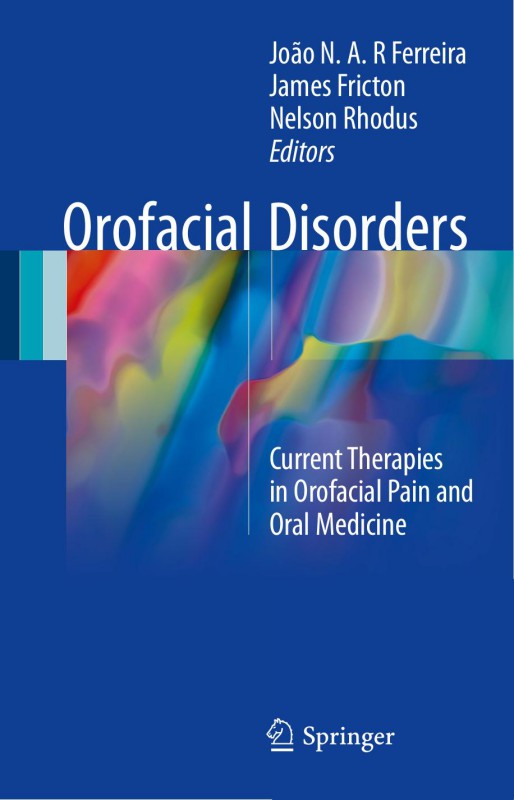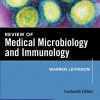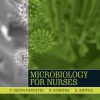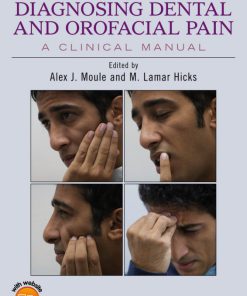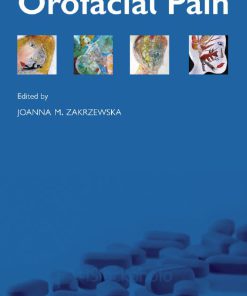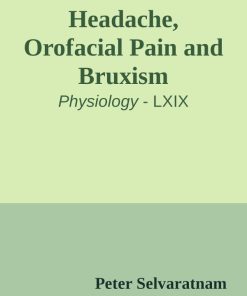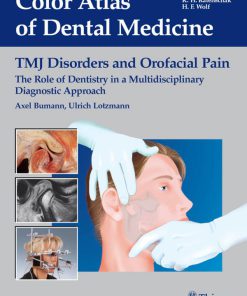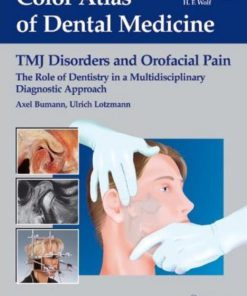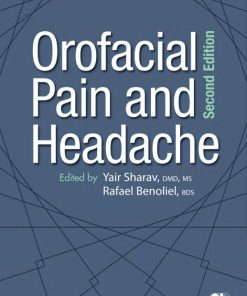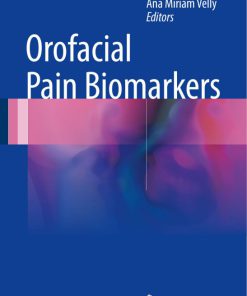Orofacial Disorders Current Therapies in Orofacial Pain and Oral Medicine 1st edition by João Ferreira,James Fricto,Nelson Rhodus 9783319515083 331951508X
$50.00 Original price was: $50.00.$25.00Current price is: $25.00.
Authors:libgen.lc , Author sort:libgen.lc , Published:Published:Jun 2017
Orofacial Disorders Current Therapies in Orofacial Pain and Oral Medicine 1st edition by João Ferreira,James Fricto,Nelson Rhodus – Ebook PDF Instant Download/Delivery.9783319515083,331951508X
Full download Orofacial Disorders Current Therapies in Orofacial Pain and Oral Medicine 1st edition after payment
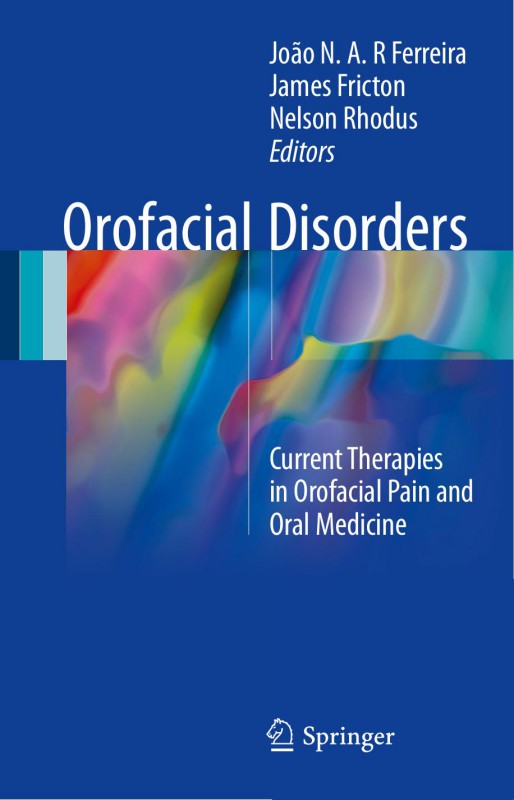
Product details:
ISBN 10:331951508X
ISBN 13:9783319515083
Author:João Ferreira,James Fricto,Nelson Rhodus
This cutting-edge book is a quick reference guide to the evidence-based evaluation, diagnosis, and management of the broad spectrum of orofacial disorders. Each chapter is devoted to a particular disease or disorder and presents advances in our understanding of the condition, the most recent evaluation and diagnostic strategies, and up-to-date treatment approaches. In addition, strategies for integration of care into routine dental practice are explained, and information provided on how to comprehensively diagnose and manage orofacial disorders. The coverage encompasses the latest technological advances in the field, such as novel pharmaceuticals, diagnostic tools, gene transfer techniques, radiotherapy modalities, and a vast array of interdisciplinary and multidisciplinary approaches including complementary and alternative therapies for orofacial disorders.Although the management of orofacial disorders is emerging as a distinct field of dentistry,many dentists and physicians are unfamiliar with recent advances in the care of patients with these disorders including orofacial pain, oral lesions and cancer, malodor, xerostomia, obstructive sleep apnea, bruxism and oral parafunctional behaviors, temporomandibular disorders, occlusal dysesthesias, orofacial neuropathic pains, and headaches. This book, written by world class experts, is deliberately geared to the level of understanding of a clinician. It will serve as an ideal evidence-based reference and source of specific clinical recommendations in daily practice.
Orofacial Disorders Current Therapies in Orofacial Pain and Oral Medicine 1st Table of contents:
Part I: Oral Cancer and Premalignant Lesions
1: Leukoplakia
1.1 Introduction
1.2 Clinical Presentation
1.3 Etiology and Epidemiology
1.4 Pathophysiology and Mechanisms
1.5 Diagnosis and Diagnostic Criteria
1.6 Rationale for Treatment
1.7 Treatment Options
1.8 Treatment Goals and Sequencing of Care
References
2: Oral Cancer
2.1 Introduction
2.2 Clinical Presentation
2.3 Etiology and Epidemiology
2.4 Pathophysiology and Mechanisms
2.5 Diagnosis and Diagnostic Criteria
2.6 Rationale for Treatment
2.7 Treatment Options
2.8 Treatment Goals and Sequencing of Care
References
3: Orofacial Pain in Cancer
3.1 Introduction
3.2 Clinical Presentation and Diagnostic Subtypes
3.3 Etiology and Epidemiology
3.4 Pathophysiology and Diagnosis: Importance on Understanding Mechanisms
3.4.1 Mechanisms of Orofacial Pain from Cancer
3.4.2 Mechanisms Due to Nonsurgical Management of Cancer
3.4.3 Mechanisms Due to Surgical Procedures for Cancer
3.4.4 Mechanisms Due to Secondary Effects from Radiotherapy and/or Chemotherapy (Mucositis)
3.4.5 Orofacial Pain Due to Other Etiologies
3.5 Rationale for Treatment
3.6 Treatment Options, Goals, and Sequence of Care
References
Part II: Oral Mucosal Diseases
4: Herpes Simplex
4.1 Introduction
4.2 Clinical Presentation
4.3 Etiology and Epidemiology
4.4 Pathophysiology
4.5 Diagnosis
4.6 Rationale for Treatment
4.7 Treatment Options
4.8 Treatment Goals
References
5: Oral Vesiculobullous Diseases
5.1 Introduction
5.2 Clinical Presentation
5.2.1 Common Symptomatology
5.2.2 Signs
5.3 Etiology and Epidemiology
5.3.1 Etiological Considerations According to Each Condition
5.4 Pathophysiology and Mechanisms
5.5 Diagnosis and Diagnostic Criteria
5.5.1 Clinical Diagnostic Criteria for OVED
5.5.2 Laboratory Diagnostic Criteria for OVED
5.6 Treatment
5.6.1 Rational for Treatment
5.6.2 Treatment Options
5.6.3 Home Care
5.6.4 Pharmacotherapy
5.6.5 Treatment Goals and Sequence of Care
References
6: Oral Candidiasis
6.1 Introduction
6.2 Clinical Presentation
6.3 Etiology and Epidemiology
6.4 Pathophysiology and Mechanisms
6.5 Diagnosis and Diagnostic Criteria
6.6 Rationale for Treatment
6.7 Treatment Options
6.8 Treatment Goals and Sequencing of Care
References
Part III: Oral Diseases of the Senses
7: Chemosensory Disorders
7.1 Introduction
7.2 Clinical Presentation
7.2.1 Smell Disorders
7.2.2 Taste Disorders
7.3 Etiology and Epidemiology
7.3.1 Prevalence
7.3.2 Etiologic Factors
7.4 Pathophysiology and Mechanisms
7.5 Diagnosis and Diagnostic Criteria
7.6 Rationale for Treatment
7.7 Treatment Options
7.7.1 Pharmacotherapy
7.7.2 Surgery
7.7.3 Miscellaneous
7.8 Treatment Goals and Sequencing of Care
References
8: Oral Malodor
8.1 Introduction
8.2 Clinical Presentation
8.3 Etiology and Epidemiology
8.4 Pathophysiology and Mechanisms
8.4.1 Oral Pathological Etiology (90% of Chronic Bad Breath)
8.4.2 Oral Physiological Factors (Not Causal But Contributing Factors to Oral Malodors)
8.4.3 Non-pathological and Nonphysiological Factors (10%)
8.4.4 Undetectable Malodor (Oral and Non-oral)
8.5 Diagnosis and Diagnostic Criteria
8.5.1 Clinical Examination
8.5.2 Subjective Sensory Evaluation Methods
8.5.3 Objective Evaluation Instruments
8.6 Rationale for Treatment
8.7 Treatment Options
8.7.1 Mechanical Debridement
8.7.2 Localized Chemical/Antibacterial Methods
8.8 Treatment Goals and Sequencing of Care
References
Part IV: Salivary Gland Dysfunctions
9: Salivary Gland Dysfunction and Xerostomia
9.1 Introduction
9.2 Clinical Presentation
9.2.1 Symptoms
9.2.2 Signs
9.3 Etiology and Epidemiology
9.3.1 Etiological Factors
9.3.2 Prevalence
9.4 Pathophysiology and Mechanisms
9.5 Diagnosis and Diagnostic Criteria
9.6 Rationale for Treatment
9.7 Treatment Options
9.8 Treatment Goals and Sequence of Care
Suggested Readings
For Further Information Visit the Following Websites
10: Gene Therapy for Radiation-Induced Salivary Hypofunction
10.1 Introduction and Diagnostic Subtypes
10.2 Clinical Presentation
10.3 Etiology and Epidemiology
10.4 Pathophysiology and Mechanisms
10.5 Diagnosis and Diagnostic Criteria
10.6 Rationale for Treatment
10.7 Treatment Options
10.7.1 Gene Transfer Strategies
10.8 Treatment Goals and Sequencing of Care
References
11: Salivary Hypofunction in Aging Adults
11.1 Introduction
11.2 Epidemiology
11.3 Diagnosis and Diagnostic Criteria
11.4 Treatment Rationale and Goals
11.5 Sequencing of Care
11.5.1 Alleviation of Symptoms
11.5.2 Avoidance Strategies
11.5.3 Prevention of Complications
11.5.4 Submandibular Gland Transfer
11.5.5 Investigational and Other Agents
References
Part V: Oral Parafunctions and Sleep Disorders
12: Oral Parafunctional Behaviors
12.1 Introduction
12.2 Clinical Presentation
12.3 Epidemiology
12.4 Pathophysiology and Mechanisms
12.5 Diagnosis and Diagnostic Criteria
12.6 Rationale for Treatment
12.7 Treatment Options
12.8 Treatment Goals and Sequencing of Care
References
13: Obstructive Sleep Apnea and Snoring
13.1 Introduction and Diagnostic Subtypes
13.2 Clinical Presentation
13.3 Epidemiology and Etiology (Risk Factors)
13.4 Pathophysiology and Mechanisms
13.4.1 Systemic Effects of OSA
13.5 Diagnosis and Diagnostic Criteria
13.6 Rationale for Treatment
13.7 Treatment Options, Goals, and Sequencing of Care
Suggested Reading
Part VI: Temporomandibular Disorders and Occlusal Dysfunction
14: Temporomandibular Joint Disorders
14.1 Introduction
14.1.1 Derangements of the Condyle-Disc Complex
14.1.2 Structural Incompatibility of the Articular Surfaces
14.1.3 Inflammatory Joint Disorders
14.2 Clinical Presentation
14.3 Etiology and Epidemiology
14.3.1 Prevalence
14.3.2 Comorbid Conditions and Complicating Factors
14.3.3 Etiologic Factors
14.4 Pathophysiology and Mechanisms
14.4.1 Biomechanical Strain Hypothesis
14.4.2 Molecular and Cellular Hypothesis
14.5 Diagnostic Criteria
14.5.1 TMJ Disc Displacement/Dislocation with Reduction
14.5.2 TMJ Acute Disc Dislocation Without Reduction
14.5.3 Chronic TMJ Disc Dislocation Without Reduction
14.5.4 Spontaneous Dislocation of the TMJ
14.5.5 Synovitis, Capsulitis, and Retrodiscitis
14.5.6 TMJ Osteoarthritis
14.5.6.1 Diagnostic Tests
14.6 Rationale for Treatment
14.7 Treatment Options
14.7.1 Self-Care
14.7.2 Pharmacotherapy
14.7.3 Physical Rehabilitation Medicine Procedures
14.7.4 Orthopedic Intraoral Splints
14.7.5 Cognitive-Behavioral Therapy (CBT)
14.7.6 TMJ Surgery
14.8 Sequence of Care
References
15: Temporomandibular Muscle Disorders
15.1 Introduction and Diagnostic Subtypes
15.2 Clinical Presentation
15.3 Etiology and Epidemiology
15.4 Pathophysiology and Mechanisms
15.5 Diagnosis and Diagnostic Criteria
15.6 Rationale for Treatment
15.7 Treatment Options
15.7.1 Myalgia
15.7.2 Myofascial Pain with Referral
15.7.3 Spasm
15.7.4 Myositis
15.8 Treatment Goals and Sequencing of Care
References
16: Orofacial Dystonias and Dyskinesias
16.1 Introduction
16.1.1 Basic Functional Neuroanatomy Review
16.2 Clinical Presentation
16.3 Etiology and Epidemiology
16.4 Pathophysiology and Mechanisms
16.5 Diagnosis and Diagnostic Criteria
16.5.1 Orofacial Dyskinesias
16.5.2 Bruxism
16.5.3 Oromandibular Dystonia
16.5.4 Orofacial Dyskinesia
16.5.4.1 Primary or Idiopathic Dyskinesia
16.5.4.2 Secondary or Tardive Dyskinesia (TD)
16.5.4.3 “Dental or Prosthetic” Dyskinesias
16.6 Rationale for Treatment
16.7 Treatment Options
16.8 Treatment Goals and Sequencing of Care
16.9 Conclusion
References
Suggested Reading
17: Occlusal Dysesthesia and Dysfunction
17.1 Introduction
17.2 Clinical Presentation
17.3 Etiology and Epidemiology
17.3.1 Epidemiology
17.3.2 Etiology
17.4 Pathophysiology and Mechanisms
17.5 Diagnosis and Diagnostic Criteria
17.6 Rationale for Treatment
17.7 Treatment Options
17.8 Treatment Goals and Sequencing of Care
References
Part VII: Orofacial Pain Disorders
18: Non-odontogenic “Tooth” Pain
18.1 Introduction and Diagnostic Subtypes
18.2 Clinical Presentation
18.3 Etiology and Epidemiology
18.4 Pathophysiology and Mechanisms
18.5 Diagnosis, Diagnostic Criteria, and Treatment
18.5.1 Musculoskeletal Pain
18.5.1.1 Myofascial Pain with Referral
18.5.2 Neuropathic Pain
18.5.2.1 Trigeminal Neuralgia (TN)
18.5.2.2 Persistent Dentoalveolar Pain Disorder (PDAP)
18.5.2.3 Neuritis
18.5.2.4 Neuroma
18.5.2.5 Post-Herpetic Trigeminal Neuropathy
18.5.3 Neurovascular Pain
18.5.4 Referred Pain from Regional or Distant Pathology
18.5.5 Pain Disorders Related to Psychological Factors
References
19: Trigeminal Neuropathic Pain and Orofacial Neuralgias
19.1 Introduction and Diagnostic Subtypes
19.2 Clinical Presentation
19.3 Etiology and Epidemiology
19.4 Pathophysiology and Mechanisms
19.5 Diagnostic Criteria and Diagnostic Tests
19.6 Rationale for Treatment
19.7 Treatment Options
19.8 Treatment Goals and Sequencing of Care
References
20: Burning Mouth Syndrome
20.1 Introduction
20.2 Epidemiology and Etiology
20.3 Clinical Presentation
20.3.1 Burning Symptoms
20.3.2 Associated Symptoms
20.3.2.1 Psychosocial
20.4 Pathophysiology and Mechanisms
20.4.1 Chorda Tympani Damage
20.4.2 Small Fiber Neuropathy
20.4.3 Other Theories
20.5 Diagnosis and Diagnostic Criteria
20.6 Rationale for Treatment
20.7 Treatment Options
20.7.1 Topical Treatment
20.7.2 Systemic Treatment
20.7.3 Complementary and Alternative Medicine Therapies
20.7.4 Cognitive Therapy
20.8 Treatment Goal and Sequencing of Care
References
Part VIII: Headaches
21: Chronic Daily Headache
21.1 Introduction
21.2 Clinical Presentation
21.2.1 Primary Headaches
21.2.1.1 Migraine
21.2.1.2 Tension-Type Headache
21.2.1.3 Cluster Headache
21.2.1.4 Trigeminal Autonomic Cephalalgias
21.2.2 Secondary Headaches
21.3 Etiology and Epidemiology
21.4 Pathophysiology and Mechanisms
21.5 Diagnosis and Diagnostic Criteria
21.5.1 Diagnosing the Headache Patient
21.5.2 Diagnostic Criteria/Taxonomy
21.6 Rationale for Treatment
21.7 Treatment Options
21.8 Treatment Goals and Sequencing of Care
References
22: Migraine
22.1 Introduction and Diagnostic Subtypes
22.2 Clinical Presentation
22.2.1 Etiology and Epidemiology
22.3 Pathophysiology and Mechanisms
22.4 Diagnosis and Diagnostic Criteria
22.5 Rationale for Treatment
22.6 Treatment Options
22.6.1 Pharmacological Therapy
22.6.1.1 Acute Therapy
22.6.1.2 Preventive Therapy
22.6.1.3 Considering Coexisting Diseases
22.6.2 Non-pharmacological Therapy
22.7 Treatment Goals and Sequencing of Care
22.7.1 Goals
22.7.2 Stratified Approach
22.7.3 Evaluating Therapy
References
23: Cluster and Facial Headache
23.1 Introduction and Diagnostic Subtypes
23.2 Clinical Presentation
23.3 Etiology and Epidemiology
23.4 Pathophysiology and Mechanisms
23.5 Diagnosis and Diagnostic Criteria
23.6 Rationale for Treatment
23.7 Treatment Options
23.8 Treatment Goals and Sequencing of Care
References
24: Migraine Variants
24.1 Introduction
24.2 Etiology, Epidemiology, Diagnostic Criteria, and Treatment of Migraine Variants
24.2.1 Late-Life Migraine
24.2.2 Migraine with Brain Stem Aura [3] (Formerly Basilar-Type Migraine or Basilar Migraine)
24.2.2.1 Pathophysiology
24.2.2.2 Treatment
24.2.3 Ophthalmoplegic Migraine
24.2.4 Hemiplegic Migraine/Familial Hemiplegic Migraine
24.2.4.1 Treatment
24.2.5 Retinal Migraine
24.2.6 Progressive Migraine (to Chronic)
24.2.7 Primary Stabbing Headache (Jabs and Jolts Syndrome)
24.2.7.1 Epicrania Fugax
24.2.8 Exertional Migraine (Primary Exercise Headache)
24.2.9 Vestibular Migraine
References
Part IX: Health Care Approaches in Orofacial and Widespread Pains
25: Interdisciplinary and Multidisciplinary Approaches to Orofacial Pain Care
25.1 Introduction
25.2 Defining Multimodal Approaches to Orofacial Pain Care
25.3 Implementation of an Interdisciplinary Approach to Orofacial Pain
25.3.1 Evaluation
25.3.2 Management Team
25.3.3 Follow-Up
25.3.4 Cost Control Using an Interdisciplinary Team
25.4 Implementation of an Multidisciplinary Approach to Orofacial Pain
25.4.1 Evaluation
25.4.2 Management
25.4.3 Follow-Up
25.5 Neurobiological Considerations in Orofacial Pain Management
References
26: Transformative Care for Orofacial Disorders
26.1 Introduction
26.2 The Problem with Orofacial Disorders
26.3 Transforming Pain to Health and Well-Being
26.3.1 Human Systems Model
26.3.2 Transformative Care
26.3.3 The Healthcare Provider as an Agent of Transformative Change
26.3.4 Determine the Complete Problem List
26.3.5 Matching Complexity of the Patient with the Complexity of Care
26.3.6 Integrative Care
References
27: Integrative Approaches to Orofacial Pain: Role of Biofeedback and Hypnosis
27.1 Introduction
27.2 Rationale for Integrative Approaches to Orofacial Pain
27.3 Integrative Therapies to Orofacial Pain
27.3.1 Stress Management
27.3.2 Control of Autonomic Dysfunction
27.3.3 Decreasing Masticatory Muscle Tension via Biofeedback
27.3.4 Hypnosis and Hypnotherapy
References
Part X: A Comprehensive Approach to Orofacial Disorders
28: History Taking and Physical Examination for Orofacial Disorders
28.1 Introduction
28.2 Oral Mucosal Diseases
28.2.1 Medical History
28.2.2 History of the Present Illness (HPI)
28.2.3 Clinical Examination
28.2.4 Diagnostic Tests
28.2.5 Adjunctive Techniques for Oral Mucosa Examination
28.2.6 Serologic Studies
28.2.7 Surgical Biopsy
28.3 Salivary Gland Disorders
28.3.1 Medical History
28.3.2 Clinical Examination
28.3.3 Saliva Collection
28.3.4 Salivary Gland Imaging
28.3.5 Plain Film Radiography
28.3.6 Sialography
28.3.7 Ultrasound (US)
28.3.8 Radionuclide Imaging (RI)
28.3.9 Computerized Tomography (CT)
28.3.10 Magnetic Resonance Imaging (MRI)
28.3.11 Positron Emission Tomography (PET)
28.3.12 Salivary Glands Biopsy
28.3.13 Serological Studies
28.4 Orofacial Pain Disorders
28.4.1 Chief Complaint and History of the Present Illness
28.4.2 Location
28.4.3 Onset
28.4.4 Quality
28.4.5 Quantity or Intensity
28.4.6 Timing
28.4.7 Modifying Factors
28.4.8 Associated Symptoms
28.4.9 Past Diagnostic Tests and Medications
28.4.10 Cranial Nerve Examination
28.4.11 Head and Neck Examination
28.4.12 Temporomandibular Joint (TMJ) Evaluation
28.4.13 Muscle Palpation
28.4.14 Oral Mucosa and Dental Examination
28.4.15 Diagnostic Anesthetic Injections
28.4.16 Serologic Studies
28.4.17 Temporomandibular Joint Imaging
28.4.18 Plain Films
28.4.19 Computed Tomography (CT)
28.4.20 Magnetic Resonance Imaging (MRI)
28.4.21 Behavioral and Psychological Assessment
People also search for Orofacial Disorders Current Therapies in Orofacial Pain and Oral Medicine 1st :
patient assessment tutorials a step-by-step guide for the dental hygienist
what are the steps to complete a physical assessment
what is a basic assessment in nursing
what are the 4 main steps in the assessment process
health assessment steps
You may also like…
eBook PDF
Orofacial Pain Biomarkers 1st edition by Jean Paul Goulet,Ana Velly 9783662539941 3662539942

